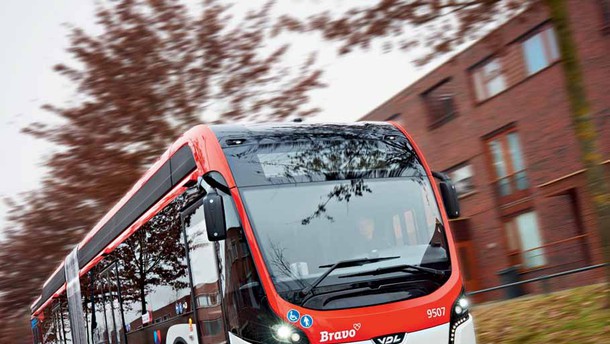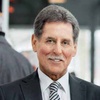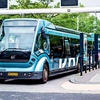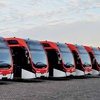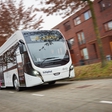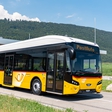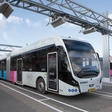
At the same time, all energy used by these buses should come from solar panels or wind farms in the same region where the buses drive. In practice, however, more than 99% of the buses were still driving on diesel last year until Eindhoven, the most important city in the south of Holland, with about 225,000 inhabitants, introduced a fleet of 43 extra-long, fully-electric buses in December 2016. Though London has, technically speaking, more buses, with 51 electric buses in a city of over 8 million inhabitants, these are all standard 12-meter-long buses, whereas Eindhoven carries many more passengers with its unique 18-meter-long, high-tech buses.
The buses are made by VDL, and Eindhoven uses the Citea SLFA Electric model, an extra-long bus with a BRT (Bus Rapid Transit) design. The vehicles have a capacity for 43 seated passengers and 82 standing passengers, and are fitted with an extra-wide entry door and full LED lighting at the front, sides and rear.
Juul van Hout is the enthusiastic regional president of Connexion, the company that owns the buses in Eindhoven. His experience with new buses has been positive, so far: "We started December 11th with 43 buses, 33 running within the timetable and 7 taking turns, while we keep 3 spare busses, in case buses need servicing. The first experiences are very positive, with many enthusiastic reactions from passengers and drivers. All buses have Wi-Fi and USB charging ports, and are very silent. In fact, the drivers need to be cautious that other road users are aware of the buses at all! We therefore equipped all buses with a special "bell," similar to those on streetcars, to enable the bus driver to warn others, when necessary." There have been some expected technical difficulties, but strangely enough, not with (empty) batteries. "During the first two weeks, we had some technical problems with a water pump, a steering pump and compressors. This has nothing to do with the bus being electric, and could happen with a diesel, as well. But malfunctions like this do often lead to a disturbance of the software, and then the bus needs to be towed away. After these first two weeks, we did not have a single issue anymore, and all buses run according to schedule," explains Van Hout. And of course the drivers had to get used to driving electric vehicles: "They need to be very disciplined, to pick the right vehicle and strictly follow the charging procedure. The buses can drive for at least three hours with their 180 kWh battery and, after that, they are fully-charged in 35 minutes with 270 kWh fast chargers during the day, or slowly with 30 kWh chargers during the night. Furthermore, our drivers need to win back sufficient energy through ecodriving." The bus company is not only replacing a part of its fleet with electric vehicles, it also promises a significant increase in both rides and passengers. Part of this is realized on the line to Eindhoven airport, which is rapidly growing.
A sustainable region
That Eindhoven has the largest fleet of electric buses in any city of mainland Europe may not come to a surprise to anyone who knows the city and the region. Eindhoven is home to the so-called High Tech Campus around the Technical University. More than 150 tech companies and research institutes, with about 10,000 researchers, are working full-speed on new innovations. Among the companies on the campus are Philips, BXP, IBM and Intel, among many smaller ones. These companies strategically share knowledge and R&D facilities, to increase the pace of innovation, especially in the areas of Health, Energy and Smart Environments. One important example is Solliance, a research organization that works with a number of hightech partners to develop the next generation of solar cells, so-called "thin-film" solar cells. These partners include Panasonic, Forschungszentrum Jülich, DSM and several others. Solliance aims to translate what has already been proven academically into high-tech production methods, through shared research programs with the business community. The importance of the tech industry in Eindhoven was officially recognized in November 2016, when the Dutch parliament decided to label this areas as a "mainport," thus giving it the same status as Schiphol Airport and Rotterdam Harbor.
Other electrical buses
The introduction of buses in Eindhoven is the biggest project among several other smaller ones in the Netherlands, and elsewhere in the region. The previous issue of Plugin Magazine discussed the introduction of 35 BYD electric buses at Schiphol Amsterdam Airport. And as of January 1, 2017, electrical buses from Arriva, one of the main public transport companies in the Netherlands, drive at the Dutch islands of Ameland, Vlieland and Terschelling, as well. The same company also introduced the first electric bus in Maastricht in December 2016, where all buses are planned to go electric within three years. In Cologne, Germany the transport company, Kölner Verkehrs-Betriebe AG (KVB), converted bus line 133 in Cologne to fully-electric. This is Germany's first 100% electric bus line in operation. They use eight VDL Citea SLFA Electric, the same buses as in Eindhoven, but with a smaller 120 kWh battery pack. And the best is still to come.... Though Eindhoven already has the most important electric bus project in Europe, the best is still to come, according to the plans of the transport company, Connexxion. Not only will many more buses be CO2 free by 2025, way ahead of the minimum demands of the Dutch government, but plans are on the drawing board for 36 meterlong super buses. Both all-electrical and equally clean hydrogen versions are developed. According to Connexxion, "Those buses are two to three times as long as the current one. In a doubledecker version, hundreds of passengers can be transported at the same time." This would revolutionize public transport, as it not only makes the current public transport CO2 free, but would dramatically expand the capacity of the bus system, thus allowing for many more passengers, and a decrease in mobility through cars. This system could potentially solve the congestion in other popular cities, like Amsterdam and Utrecht. Both the current experiences and the plans for the future may point the way for both cities and the bus sector around Europe.
Text: Edgar Tijhuis
Photo: Connexion
